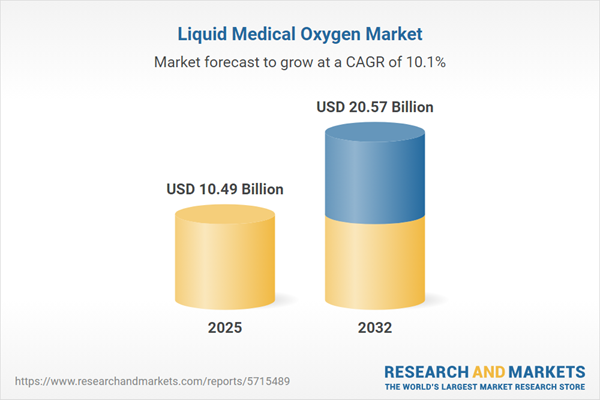Speak directly to the analyst to clarify any post sales queries you may have.
Liquid medical oxygen is foundational to reliable healthcare delivery, supporting critical respiratory care and enabling modern operational models in hospitals and clinics. As industry leaders adapt to rising complexity and evolving regulations, secure and efficient oxygen supply chains are central to sustaining patient care and organizational resilience.
Market Snapshot: Trends in the Liquid Medical Oxygen Market
The liquid medical oxygen market is demonstrating consistent and robust growth, advancing from USD 9.52 billion in 2024 to USD 10.49 billion in 2025, and is on track to more than double by 2032, propelled by a compound annual growth rate (CAGR) of 10.09%. Key drivers behind this expansion include broader healthcare access, ongoing innovations in oxygen therapy, and the integration of digital technologies. Senior decision-makers are sharpening their focus on digital tools and automation to optimize procurement, streamline distribution, and safeguard continuous oxygen supply across diverse care settings. As patient care models adapt and regulatory expectations evolve, dynamic supply chain strategies remain vital for meeting operational demands.
Scope & Segmentation: Key Segments and Regional Insights
- End User: Clinics deploy advanced oxygen generation systems with digital monitoring to ensure continuous onsite supply. Hospitals prioritize automated storage and refill workflows to boost system reliability and operational efficiency. Diagnostic centers require uninterrupted access to liquid medical oxygen to maintain precision in testing outcomes. Emergency medical services value portable delivery systems which support rapid, flexible response. Home care providers extend digital patient monitoring for timely interventions and improved at-home care results.
- Supplier Type: Merchant suppliers maintain broad cryogenic pipeline and maritime delivery infrastructure, covering large networks of healthcare facilities. On-site production suppliers deliver more localized supply control and enable faster response capabilities, supporting operational flexibility and redundancy benefits.
- Distribution Channel: Automated cryogenic transport and IoT-enabled cylinders improve inventory management accuracy and ease compliance with safety standards. Micro-pipeline solutions provide efficient, monitored delivery for both urban healthcare hubs and remote locations.
- Sales Channel: Direct service contracts offer customized, rapid support for healthcare providers. Digital subscription models extend seamless oxygen availability to remote, outpatient, or distributed care environments, maintaining reliable supply amid fluctuating demand.
- Geography: The Americas benefit from mature infrastructure and prompt adoption of advanced technologies, spurring market progression. Europe, Middle East, Africa, and Asia-Pacific display varied logistics, procurement practices, and regulatory landscapes, each shaped by unique local requirements and supply chain maturity.
- Companies Covered: Linde plc, Air Liquide SA, Air Products and Chemicals, Inc., Messer Group GmbH, Taiyo Nippon Sanso Corporation, Iwatani Corporation, Matheson Tri-Gas, Inc., Gulf Cryo Holding PJSC, INOX Air Products Private Limited, and SIAD SpA lead industry infrastructure updates and promote best practices throughout the sector.
Key Takeaways for Senior Decision-Makers
- On-site generation technologies increase supply assurance and mitigate risks linked to external disruptions, advancing organizational flexibility.
- IoT-equipped assets facilitate real-time monitoring and predictive maintenance, empowering leadership with actionable insights to support multiple care environments.
- Sustainable practices such as reusable containers and efficient transport help organizations balance sustainability objectives, cost efficiency, and regulatory expectations in their oxygen supply chain.
- Continuous safety upgrades, supported by targeted staff training, reinforce adaptability to evolving standards and compliance requirements.
- Automated procurement and inventory management streamline resource allocation, allowing distributed care teams to proactively meet patient needs.
- Collaborations between liquid medical oxygen suppliers and care providers enhance supply chain resilience, supporting cross-regional compliance and robust service continuity.
Tariff Impact: Cost Pressures and Adaptive Strategies
- Policy adjustments in tariff structures are driving increased adoption of domestic and decentralized production, bolstering fiscal management and supply independence for care organizations.
- Real-time tracking and micro-pipeline investments bring greater transparency to logistics workflows, facilitating compliance and minimizing supply chain bottlenecks.
Methodology & Data Sources
This report employs a mixed-methods approach, integrating secondary data analysis, expert interviews, stakeholder surveys, and dedicated workshops. These combined sources ensure a comprehensive understanding of technology advances, usage patterns, and operational best practices shaping today’s liquid medical oxygen strategies.
Why This Report Matters
- Enables organizations to anticipate regulatory or operational shifts, underpinning risk management and agile supply planning.
- Delivers actionable benchmarks for digital workflows and procurement, supporting efficiency improvements and readiness for changing market conditions.
- Empowers evidence-based strategy development focused on sustaining growth and operational strength within intricate healthcare ecosystems.
Conclusion
Digital innovation and adaptive supply chain practices are essential for maintaining uninterrupted access to liquid medical oxygen. Organizations prioritizing these strategies will strengthen resilience and readiness for ongoing sector changes.
Additional Product Information:
- Purchase of this report includes 1 year online access with quarterly updates.
- This report can be updated on request. Please contact our Customer Experience team using the Ask a Question widget on our website.
Table of Contents
3. Executive Summary
4. Market Overview
7. Cumulative Impact of Artificial Intelligence 2025
Companies Mentioned
The companies profiled in this Liquid Medical Oxygen market report include:- Linde plc
- Air Liquide SA
- Air Products and Chemicals, Inc.
- Messer Group GmbH
- Taiyo Nippon Sanso Corporation
- Iwatani Corporation
- Matheson Tri-Gas, Inc.
- Gulf Cryo Holding PJSC
- INOX Air Products Private Limited
- SIAD SpA
Table Information
| Report Attribute | Details |
|---|---|
| No. of Pages | 186 |
| Published | October 2025 |
| Forecast Period | 2025 - 2032 |
| Estimated Market Value ( USD | $ 10.49 Billion |
| Forecasted Market Value ( USD | $ 20.57 Billion |
| Compound Annual Growth Rate | 10.0% |
| Regions Covered | Global |
| No. of Companies Mentioned | 11 |









